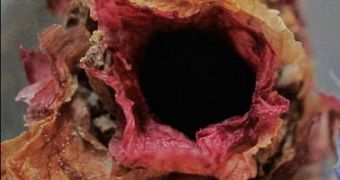Biologists were surprised to learn that a certain species of bees tends to avoid living in the harsh environment that is the beehive, and prefer to design luxury suites for themselves. The insects in question, called Osmia avoseta, are Middle Eastern bees that construct nests which are the height of comfort and luxury. The creatures line the insides with colorful flower petals, producing a place that they are most likely happy to call home. This catches on a new dimension when considering that this is a solitary species, which means that all individuals prefer to live by themselves, LiveScience reports.
In fact, about three quarters of all bee species, about 20,000 total, are classified as solitary. Member of the O. avoseta species construct individual nests that are 1.5 to 5 centimeters (0.5 to 2 inches) underground. Females are in charge with decorating the habitat, and they cover the chamber, or chambers, in colorful petals collected from nearby plants. The sequence of steps is always the same, the researchers behind the new study say. The females start from the bottom, and adorn the one or two “rooms” with overlapping purple, yellow, blue and pink petals.
But that is not all. Once they are done with the first layer, the female bees apply a layer of plaster – clay-like mud that comes onto the surface of the first layer of petals. The glue-like substance gets deposited in a layer just half of a millimeter thick. As soon as the plaster is applied, the bees then proceed to placing the second layer of overlapping petals. The end result can best be described as a sandwich, the investigators say, with the clay acting like the filling. But the reason why the bees create these complex structures is not aesthetics, the researchers add.
They explain that the females then place nectar and pollen in various mixes on the chamber floor, and deposit their eggs. Once this is done, they exit the room, and then seal it by folding the petals at its top. They place additional mud on the petals, so as to close them shut. The entire shell then hardens, and produces a protective cocoon, in which the next generation of bees can hatch. After consuming the pollen and nectar mix, the young bees begin spinning their cocoons, and then start their 10-month metamorphosis. After this stage is completed, they will emerge from the chamber fully-grown adults, right in the springtime.
“Unfortunately, her larvae never enjoy the brilliant colors of the nest's walls because they have no eyes. And, anyhow, they would need a flashlight,” says American Museum of Natural History Division of Invertebrate Zoology curator and researcher, Jerome Rozen. “The architecture of the way these whole things [chambers] are constructed is quite remarkable,” the expert adds. Details of the investigation appear in the February issue of the respected scientific journal American Museum Novitates.

 14 DAY TRIAL //
14 DAY TRIAL //